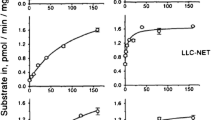Abstract
The non-neuronal monoamine transporters OCT1, OCT2 and EMT (human gene symbols SLC22A1-A3) efficiently transport a number of positively-charged monoamines and some small organic cations across the plasma membrane, and thus are implicated in the inactivation of released monoamine transmitters (e.g. noradrenaline, histamine, agmatine) in vivo. Although prostaglandins are full anions at physiological pH, data from a recent publication suggest efficient transport of the prostaglandins PGE2 and \({\text{PGF}}_{{{\text{2 $\alpha $ }}}}\) by OCT1 and OCT2. In the present study we have reexamined transport of PGE2 by OCT2 from human (OCT2h). Uptake of substrate into monolayers of 293 cells, stably transfected to express OCT2h, was compared to uptake into non-transfected control cells. Efficiency of transport of the established substrate 3H-1-methyl-4-phenylpyridinium (MPP+), expressed as clearance, was high at 81 μl min−1 mg protein−1 on average. By contrast, uptake of 3H-PGE2 was virtually identical for control cells and OCT2h cells. The efficiency of transport was 0.1±0.6, 1.0±0.3, and 0.7±0.4 μl min−1 mg protein−1 for cell lysis with methanol, HClO4, and Triton X-100 respectively. Similar results were obtained with unlabeled MPP+ (192±12 μl min−1 mg protein−1) and PGE2 (0.3±0.1 μl min−1 mg protein−1) in LC-MS/MS analysis. We conclude that OCT2h is not capable of transporting prostaglandins. The data from the previous report may represent binding rather than transport. Our comparison of transport efficiencies confirms the notion that relevant substrates of OCT1, OCT2, and EMT must carry a positive charge.





Similar content being viewed by others
Abbreviations
- EMT:
-
extraneuronal monoamine transporter
- LC:
-
liquid chromatography
- MPP+ :
-
1-methyl-4-phenylpyridinium
- MS:
-
mass spectrometry
- OAT:
-
organic anion transporter
- OCT:
-
organic cation transporter
- TEA:
-
tetraethylammonium
References
Boushel R, Langberg H, Risum N, Kjaer M (2004) Regulation of blood flow by prostaglandins. Curr Vasc Pharmacol 2:191–197
Breidert T, Spitzenberger F, Gründemann D, Schömig E (1998) Catecholamine transport by the organic cation transporter type 1 (OCT1). Br J Pharmacol 125:218–224
Chan BS, Satriano JA, Pucci M, Schuster VL (1998) Mechanism of prostaglandin E2 transport across the plasma membrane of HeLa cells and xenopus Oocytes expressing the prostaglandin transporter “PGT”. J Biol Chem 273:6689–6697
Eraly SA, Nigam SK (2002) Novel human cDNAs homologous to Drosophila Orct and mammalian carnitine transporters. Biochem Biophys Res Commun 297:1159–1166
Funk CD (2001) Prostaglandins and leukotrienes: advances in eicosanoid biology. Science 294:1871–1875
Gorboulev V, Ulzheimer JC, Akhoundova A, Ulzheimer-Teuber I, Karbach U, Quester S, Baumann C, Lang F, Busch AE, Koepsell H (1997) Cloning and characterization of two human polyspecific organic cation transporters. DNA Cell Biol 16:871–881
Gründemann D, Schömig E (2003) Organic cation transporters. In: Rosenthal W, Offermanns S (eds) Encyclopedic reference of molecular pharmacology. Springer, Berlin Heidelberg New York, pp 696–701
Gründemann D, Gorboulev V, Gambaryan S, Veyhl M, Koepsell H (1994) Drug excretion mediated by a new prototype of polyspecific transporter. Nature 372:549–552
Gründemann D, Babin-Ebell J, Martel F, Örding N, Schmidt A, Schömig E (1997) Primary structure and functional expression of the apical organic cation transporter from kidney epithelial LLC-PK1 cells. J Biol Chem 272:10408–10413
Gründemann D, Köster S, Kiefer N, Breidert T, Engelhardt M, Spitzenberger F, Obermüller N, Schömig E (1998a) Transport of monoamine transmitters by the organic cation transporter type 2 (OCT2). J Biol Chem 273:30915–30920
Gründemann D, Schechinger B, Rappold GA, Schömig E (1998b) Molecular identification of the corticosterone-sensitive extraneuronal monoamine transporter. Nat Neurosci 1:349–351
Gründemann D, Liebich G, Kiefer N, Köster S, Schömig E (1999) Selective substrates for non-neuronal monoamine transporters. Mol Pharmacol 56:1–10
Gründemann D, Hahne C, Berkels R, Schömig E (2003) Agmatine is efficiently transported by non-neuronal monoamine transporters EMT and OCT2. J Pharmacol Exp Ther 304:810–817
Iversen LL (1965) The uptake of catechol amines at high perfusion concentrations in the rat isolated heart: a novel catechol amine uptake process. Br J Pharmacol 25:18–33
Jonker JW, Schinkel AH (2004) Pharmacological and physiological functions of the polyspecific organic cation transporters: OCT1, 2, and 3 (SLC22A1-3). J Pharmacol Exp Ther 308:2–9
Kanai N, Lu R, Satriano JA, Bao Y, Wolkoff AW, Schuster VL (1995) Identification and characterization of a prostaglandin transporter. Science 268:866–869
Kimura H, Takeda M, Narikawa S, Enomoto A, Ichida K, Endou H (2002) Human organic anion transporters and human organic cation transporters mediate renal transport of prostaglandins. J Pharmacol Exp Ther 301:293–298
Koepsell H (2004) Polyspecific organic cation transporters: their functions and interactions with drugs. Trends Pharmacol Sci 25:375–381
Koepsell H, Endou H (2004) The SLC22 drug transporter family. Pflügers Arch 447:666–676
Koepsell H, Schmitt BM, Gorboulev V (2003) Organic cation transporters. Rev Physiol Biochem Pharmacol 150:36–90
Russ H, Engel W, Schömig E (1993) Isocyanines and pseudoisocyanines as a novel class of potent noradrenalin transport inhibitors: synthesis, detection, and biological activity. J Med Chem 36:4208–4213
Schömig E, Schönfeld CL (1990) Extraneuronal noradrenaline transport (uptake2) in a human cell line (Caki-1 cells). Naunyn-Schmiedeberg's Arch Pharmacol 341:404–410
Schömig E, Spitzenberger F, Engelhardt M, Martel F, Örding N, Gründemann D (1998) Molecular cloning and characterization of two novel transport proteins from rat kidney. FEBS Lett 425:79–86
Smith PK, Krohn RI, Hermanson GT, Mallia AK, Gartner FH, Provenzano MD, Fujimoto EK, Goeke NM, Olson BJ, Klenk DC (1985) Measurement of protein using bicinchoninic acid. Anal Biochem 150:76–85
Trendelenburg U (1988) The extraneuronal uptake and metabolism of catecholamines. In: Trendelenburg U, Weiner N (eds) Catecholamines I. Springer, Berlin Heidelberg New York, pp 279–319
Acknowledgements
We thank Beatrix Steinrücken for skillful technical assistance.
Author information
Authors and Affiliations
Corresponding author
Additional information
Supported by Deutsche Forschungsgemeinschaft (SCHO 373/4-1)
Rights and permissions
About this article
Cite this article
Harlfinger, S., Fork, C., Lazar, A. et al. Are organic cation transporters capable of transporting prostaglandins?. Naunyn Schmied Arch Pharmacol 372, 125–130 (2005). https://doi.org/10.1007/s00210-005-0011-8
Received:
Accepted:
Published:
Issue Date:
DOI: https://doi.org/10.1007/s00210-005-0011-8




